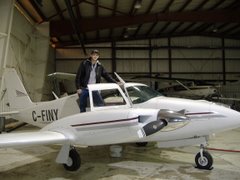Its been a while since I've written. After we finished France I got the winter off from flying. Bought a house, renovated said house, moved into house. Spent time with friends and family. Life is good. Back to flying.
We've since finished a 6 week job in Ireland. Other than being threatened to get shot down by a wacked out lady, being accused of flying "WAY too low" by some local pilots who know nothing about survey flying, and having numerous weather delays from Irish weather, the job went pretty well. Ireland itself was pretty cool though. It lives up to most of its stereotypes... I thought so at least.
As of the end of Ireland I'm still 12 flight hours short of the insurance minimums to be Captain on the Navajo, but that will be remedied shortly on our next job. Since Ireland I've had a couple weeks off, and am gearing up for shipping out to Newfoundland for our next contract. This job is going to be an offshore survey, so there's some special safety precautions that we need to take. Neither myself nor the other pilot going with me has any time flying offshore survey, but our Chief Pilot has. So in addition to spending some time at the office here getting things ready to go, we've spent some time talking to him to get some pointers and advice on offshore flying.
As part of our Maritime survival equipment, we carry onboard an inflatable life raft, but also we will be wearing Immersion Survival Suits. These are basically a one piece foam insulated jump suits that cover us head to toe to keep us warm and dry in the event that we have to ditch into the Atlantic Ocean. We'll be wearing them full time throughout all our flights offshore. At least we'll have our feet in them and will keep the top half unzipped around our waste. Its quite the monstrosity to put on and wear! Its basically impossible to fly an airplane while wearing them fully. They completely mummify you, including your hands and a rubberised hood that covers everything but your face. For your hands, imagine Pooh Bear. You can't do much. In fact its quite the feat to even get out of your seat and get the aircraft door open with the suit on, so that's what we practised today. We intend to practise some more evacuation drills once we arrive onsite. They say when you ditch an aircraft you have 30 seconds between the time you crash and when the cabin has filled with water and panic sets in, so that will be our goal: Get our arms in and zip up the top half of our immersion suit and evacuate the aircraft in less than thirty seconds.
Subscribe to:
Post Comments (Atom)




No comments:
Post a Comment